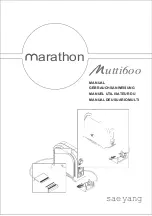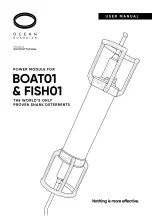
Contents
Contains one complete SUCCEED
®
equine fecal occult blood test,
including:
• 1 clear plastic container
• 1 dual test cassette – contains both an albumin test (Test A)
and a hemoglobin test (Test H)
• 1 disposable sample pipette
• 1 polyethylene glove
• 1 instruction sheet
• 1 desiccant pouch (for moisture)
Intended Use
The SUCCEED
®
Equine Fecal Blood Test™ (FBT) is a qualitative
lateral-flow rapid test that detects horse hemoglobin and albumin
in equine fecal specimens. The SUCCEED FBT is for veterinary use
only, for use as a diagnostic aid in assessing GI tract conditions in
their equine patients.
test MeChanIsM
The SUCCEED FBT utilizes proprietary antibodies to equine albumin
and hemoglobin, and has been calibrated to detect levels consistent
with a disease condition. (See Figure 1, page 2 for detection limits.)
Test A detects albumin in feces, which indicates injury equivalent to
grade 2 or higher at locations caudal to the common bile duct in the
duodenum (or, generally in the hindgut). Test H detects hemoglobin
in feces, which indicates injury equivalent to grade 2 or higher
anywhere along the GI tract of the horse. Taken together, the two
parts of the test may provide a means of distinguishing foregut and
hindgut conditions in horses.
PreCaUtIons
• For veterinary use only.
• For
in vitro
diagnostic use.
• Note: the SUCCEED FBT is a medical device and must be handled
with care.
• Do not use after expiration date, which is printed on the
back of the test cassette and outside foil pack.
• Keep specimen clear of any potential contaminants. Use only the
provided plastic container to collect and mix the fecal sample.
• Keep test cassette in sealed foil pack until use. Exposure to
moisture will affect antibodies.
• Product may be safely shipped throughout the year, and safely
used in temperatures between 5° C and 30° C (40° F to 85° F).
• Keep product refrigerated when not in use. Keep out of direct
sunlight or heat sources.
PatIent ConsIderatIons
1. Check horse for signs of external bleeding where blood may be
introduced to the digestive tract, particularly around the mouth.
2. Avoid testing horses within 48 hours of racing, especially those
prone to bleeding (i.e., exercise induced pulmonary hemorrhage)
where horse may swallow blood.
3. Avoid testing horses within 48 hours of having teeth floated.
4. Avoid testing mares during ovulation or immediately
post-partum, where bleeding may be present.
5. Avoid testing horses within five days following anthelmintic
treatment.
Observe results after applying the solution to each of the two
sample wells on the cassette, per instructions at left.
1. If a Control line does not appear within 15 minutes (at the
CTL point on the cassette) that test result is invalid. The test
must then be repeated with a new SUCCEED Equine Fecal
Blood Test.
2. If only a Control line appears on either strip, that test is
NEGATIVE.
NOTE: only a complete line is a meaningful result.
3. If both the Control and Test lines appear on either window (Test
A or H), this indicates a POSITIVE test result.
Even if the test
line is faint, the test is POSITIVE.
4. Do not read test results after 15 minutes.
If you have questions about reading the SUCCEED Equine
Fecal Blood Test, please call: 800-281-6727 from 8AM - 5PM ET
Monday through Friday.
1
InstrUCtIons
1. Remove all items from the plastic container and set aside. Do not
discard container lid.
2. Using provided glove, carefully collect fecal material from a
single, fresh, complete bowel movement of subject horse. (Feces
should be as fresh as possible, never more than 4 hours old.)
Collect about a pinch from multiple locations in a complete fecal
specimen.
Do not palpate to obtain sample.
3 Drop each pinch-sized sample into the plastic container up to the
Sample Fill Line (lower line) on the label.
Allow fecal matter to sit
loosely in the container – do not pack or compress.
4. Add clean (potable) tap water to the fecal matter in the container.
Fill to the Water Fill Line (top line). Do not use water from dirty
containers or from sources that may be contaminated with
equine blood. Water should be room temperature.
5. Replace cap on container, and
shake vigorously
to mix fecal
matter and water. Set container on a flat surface, and remove lid.
6. Open foil pack and remove test cassette and sample pipette.
(Discard empty foil pack and desiccant pouch.)
readIng the tests
CTL
CTL
TST
TST
A
H
Control
Test
If a solid line appears only at the CTL point (Control line) on either
Test A or Test H, this is a NEGATIVE result.
NEGATIVE TEST RESULT
Test Window
Sample Well
7. Use provided disposable pipette to collect solution from
container. Collect liquid only, minimizing particles. For best
results: (i) tip jar slightly, (ii) depress pipette bulb before
placing in solution, (iii) insert tip of pipette below surface of
solution and release bulb
slowly
to draw up solution.
8. Apply 2 drops of solution from pipette to EACH of the two
sample wells. Depress pipette bulb slowly to produce large
drops.
Watch for liquid to wick up the membrane in the test window:
it should wick to above the CTL line in 2-3 minutes. If wicking
does not occur, check that well is not clogged with silt, and
apply one more drop ONLY to non-wicking well. (Excess fluid
can flood the test, negating the result.)
9. Read results. A positive result may appear within
5 minutes after solution has clearly wicked up test
membrane, but may take longer. DO NOT read
results after 15 minutes. If a line appears at the TST
point on either the Test A or Test H window, that is a
positive test.
Note that even a faint line reflects a
positive test.
CTL
CTL
TST
TST
CTL
CTL
TST
TST
CTL
CTL
TST
TST
If a complete, solid line appears at the TST point (Test line) on either
or both Test A and Test H, that is a POSITIVE test result. Test A
detects equine albumin. Test H detects equine hemoglobin.
Note – even if the test line is faint, the test is POSITIVE.
POSITIVE TEST RESULTS
Positive Test A
Negative Test H
Negative Test A
Positive Test H
Positive Test A
Positive Test H
A
H
A
H
A
H
Control
Test
Failure to carefully follow these instructions may lead to incorrect interpretation.
CTL
CTL
TST
TST
A
H
CTL
CTL
TST
TST
A
H
CTL
CTL
TST
TST
A
H
CTL
CTL
TST
TST
A
H
Positive Result
Positive Result




















